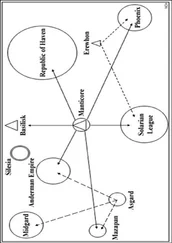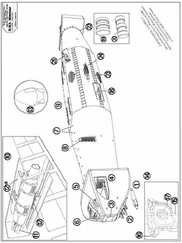MARK II BOLO (2015):
The Mark II was an updated Mark I, with greatly improved onboard computers and the same main armament, but with the first light lateral infinite repeater armament (four railguns in two two-gun batteries). Fitted with gatling and counter-missile point defense. First durachrome armor (10 millimeter) capable of defeating any weapon short of the Bolo’s own DSFSLRP round. Electronics were designed to allow a single crewman to assimilate data and operate the entire system, and weight rose to 194 metric tons. The Mark II’s fossil fuel power plant drove electric generators rather than powering its drive train directly, and the vehicle had a limited (12-hour) backup power supply of ionic batteries. The Mark II could also operate on electrical power from a secondary source (such as local civilian generator capacity) to maintain long-term readiness in the area defense role. Maximum speed was approximately 80 kph (road) to 30 kph (cross-country in average terrain). The Mark II was the last Bolo with only two tread systems; all later marks were designed with “wide track” treads-that is, with multiple track systems across the full width of the vehicle to reduce ground pressure to the lowest possible value.
MARK III BOLO (2018):
A near contemporary of Mark II, the Mark III was actually designed as a “heavy” (300 metric tons) companion vehicle. The Mark III’s single 150mm main gun (which was not turreted and had only a 20 degree traverse) was backed by an 8-gun infinite repeater battery, a heavy indirect fire support capability (four 155mm howitzers and a light VLS missile system), and an upgraded anti-missile armament. Unlike the Mark II, the Mark III carried only a single fossil-fueled power plant, strictly for backup use; power was normally drawn from heavy banks of ionic batteries, and the Mark III was the first Bolo designed from the outset to use solar film recharging. The vehicle also carried a marginally better sensor suite and a thicker durachrome hull (20 millimeter) which could be pierced at pointblank range (250 meters or less) by a 90 degree hit with the 140mm or 150mm DSFSLRP round; otherwise, it was effectively immune to anything short of a contact nuclear explosion. The Mark III was designed for a two-man crew with the second crewman serving as electronics officer (EW, sensors, etc.), but could be crewed by a single experienced operator in a pinch. The last Pre-Collapse Bolo, it was the first Bolo with multiple tread systems-inner and outer-with an independent power train for the inner pair, but maximum speed fell to 50 kph (road), 25 kph (cross-country).
MARK IV BOLO (2116):
The first Post-Collapse Bolo picked up where the Mark II left off. The Mark IV had a much improved sensor suite and carried a main armament of one 165mm railgun, backed by six infinite repeater railguns (20mm). The Mark IV was the first Bolo to use energy weapons (laser clusters) to supplement projectile weapons in the point defense role and was fitted with seventy-five vertical launch system missile cells in its after decking, capable of accepting indirect fire support or SAM loads but without onboard reloads. Powered as Mark III, but with improved solar film. (It was no longer necessary to stop and deploy acres of film; the Mark IV could recharge on the move in average daylight conditions.) The Mark IV’s durachrome hull was thicker (30 millimeter), yet weight dropped to 210 tons in the Model B, with a maximum speed of 60 kph (road) and 30 kph (cross-country). Missile load and sensor upgrades continued to drive up the tonnage of successive models, however; by the end of its active life, the Mark IV did carry onboard missile reloads and weight had risen to over 340 tons while maximum road speed fell to 40 kph, with very limited rough terrain capability. (The Mark IV, Model H, for instance, could get through almost anything, but its suspension and power train weren’t up to crossing rough terrain at any kind of speed.)
MARK V BOLO (2160):
The first member of a family of specialists with roughly comparable onboard computer support but different weapons fits and functions. The Mark V was the first so-called “deep-wader”—that is, it no longer required bridging support, as it was designed to cross water barriers (including lakes and even small seas) by submerging and driving across their bottoms-and this capability became standard with all subsequent marks of Bolo. Power demands continued to grow, surpassing levels which even ionic battery technology could meet, and the Mark V was the first Bolo to use an onboard fission power plant. The growing size and weight of later models of the Mark IV had led to efforts to diversify design in the immediately subsequent marks, and the Mark V was the “general battle tank,” fitted with a heavy caliber railgun (190mm) for main armament, supported by twin lateral batteries of six 60mm “gatling-style” infinite repeaters using spent uranium slugs and lighter gatlings and laser clusters for point defense. The laser clusters’ anti-personnel function was limited, and the Mark V also saw the first use of multishot anti-personnel flechette/HE clusters, which became standard on all subsequent Bolos. Missile capacity was severely down-sized and restricted to SAMs as part of the drive to hold down weight. The Mark V had a one-man crew, a battle weight of approximately 198 metric tons, and a maximum speed of 50 kph (cross-country) to 80 kph (road).
MARK VI BOLO (2162):
The Mark VI was the direct descendent of the Mark III “mobile firebase” concept. It had the same power plant and computer support as the Mark V, but the Mark VI’s “main battery” was its missile load, which was configured for maximum flexibility. No railgun main armament was mounted, but the 60mm infinite repeaters were upgraded to seven guns per side, and a heavier point defense battery intended to provide cover for other friendly units and to protect the Bolo itself when operating in counter-battery mode was fitted. One-man crew; 238 tons; speed roughly comparable to the Mark V’s.
MARK VII BOLO (2163):
The Mark VII was a “heavy” Bolo, whose introduction inspired the first use-though still unofficially-of the term “siege unit.” It had the same electronics fit as Marks V and VI, but its main direct-fire armament was one 200mm railgun backed by fourteen heavier (75mm) infinite repeaters. The Mark VII’s heavy missile load was biased towards the bombardment function, but it was equally capable of operating SAMs in the area defense role. This vehicle has a very heavy layered durachrome war hull (120 millimeter) and required a two-man crew, rather than the Mark V’s and VI’s one-man crew, but in the VII/B the second crewman served solely to control the indirect fire armament. In later models, the second position was upgraded to a dedicated air-defense/missile intercept function. Weight was approximately 348 tons in the Model B, with a maximum road speed of 40 kph and a maximum cross-country speed of 30 kph. (The Mark VII was never very fast, but its sheer mass meant most terrain features tended to crumple when it hit them and so did not slow it as severely.)
MARK VIII BOLO (2209):
The Mark VIII was the next-generation “main battle” (or “standard”) Bolo. Main armament remained a railgun, though muzzle velocity increased still further and projectile size fell slightly (to 170mm), but this Bolo marked the first appearance of energy-weapon (laser) infinite repeaters. (By the time of the Mark VIII, any Bolo’s secondary battery had come to be referred to as “infinite repeaters” whether or not they fired actual projectiles.) Although the new laser infinite repeaters were actually marginally less effective than the last-generation railgun infinite repeaters on an energy-transfer-per-hit basis, mass per weapon fell, and the shift meant magazine capacity for the secondary battery was no longer a design factor. Missile capability was limited to the SAM and point defense role, but the Mark VIII received four hull-mounted 150mm rapid fire howitzers to compensate. The VIII/B was fission-powered, with solar charge backup capability, a one-man crew, and a weight of approximately 225 tons. Improved power train and suspension permitted a sustained road speed of 65 kph and short-range “sprint” speeds of up to 85 kph, but maneuverability at high speed was poor.
Читать дальше












